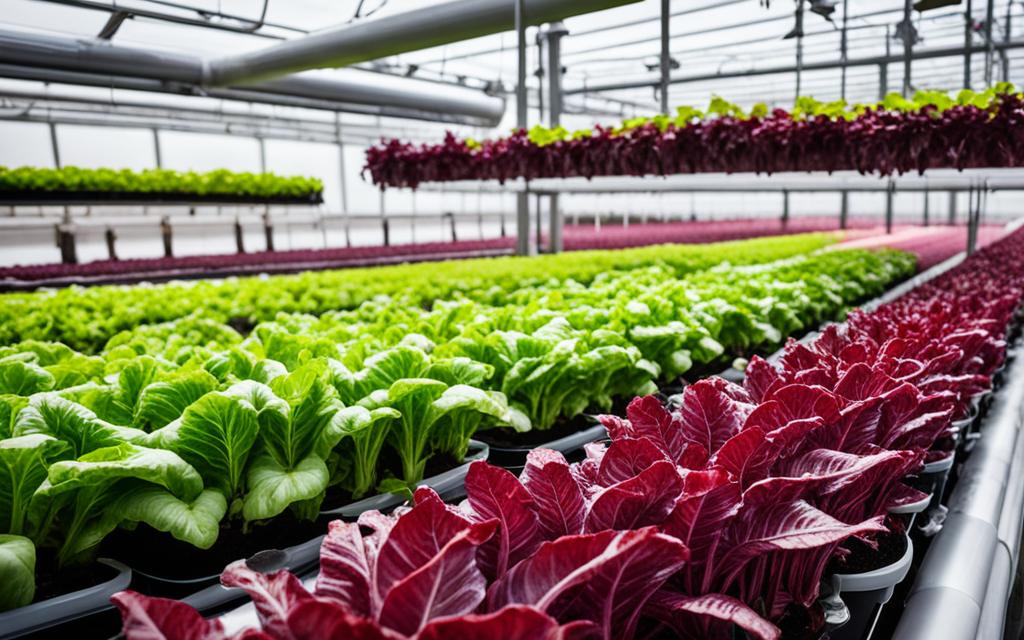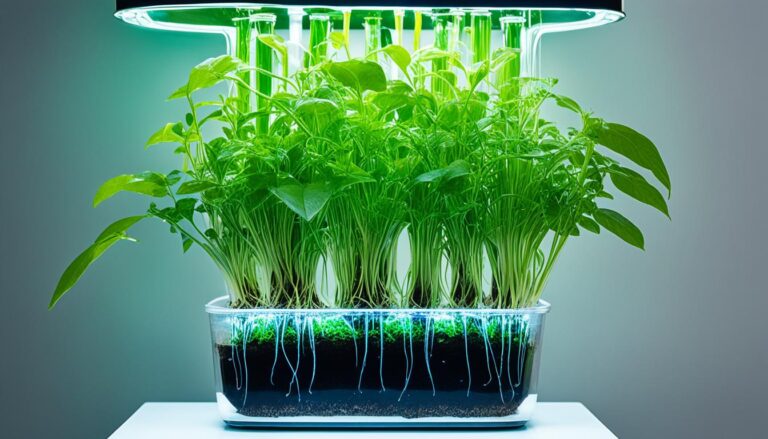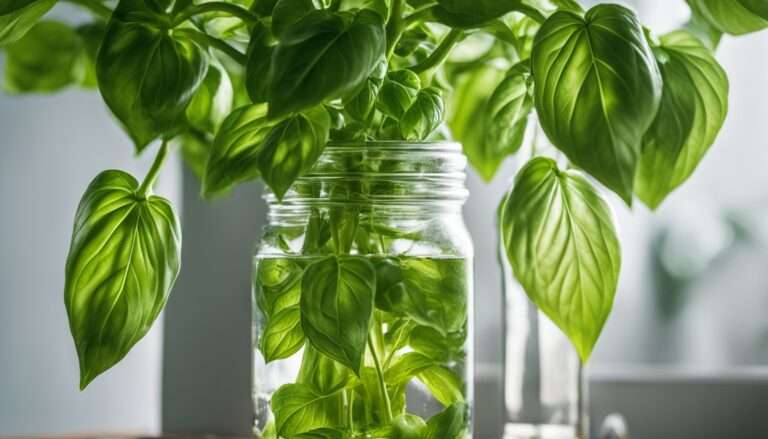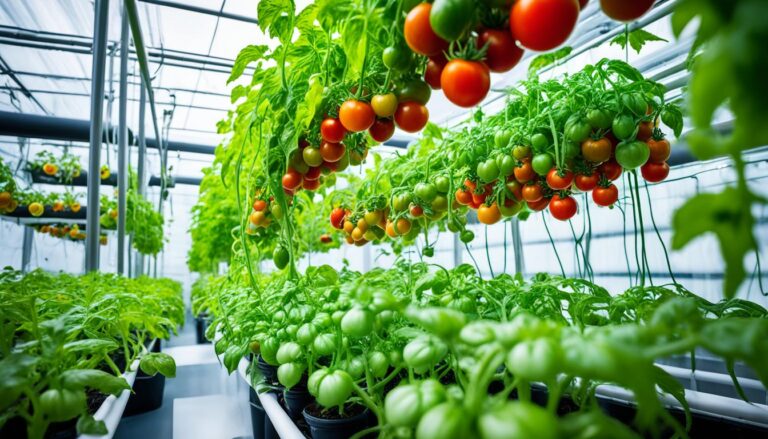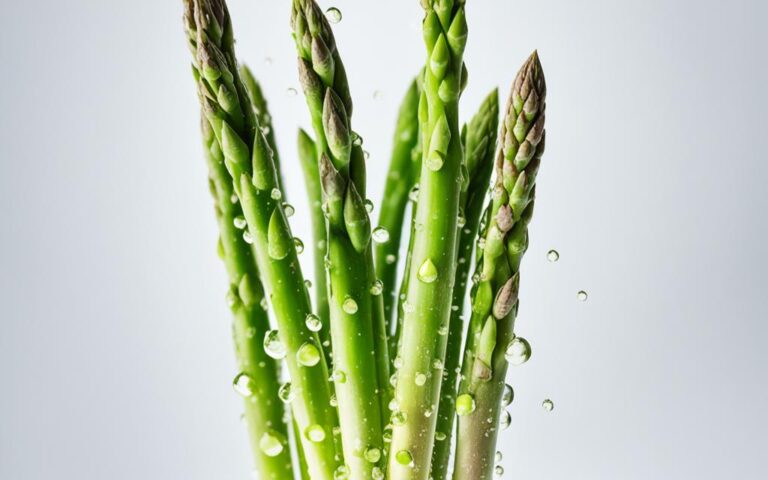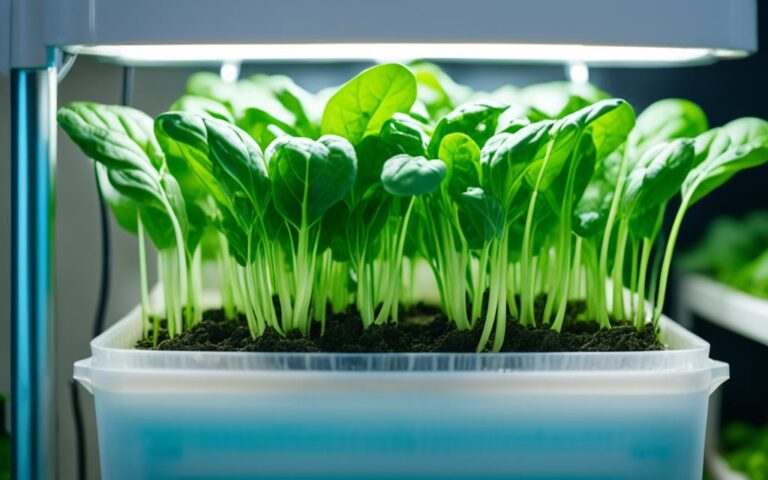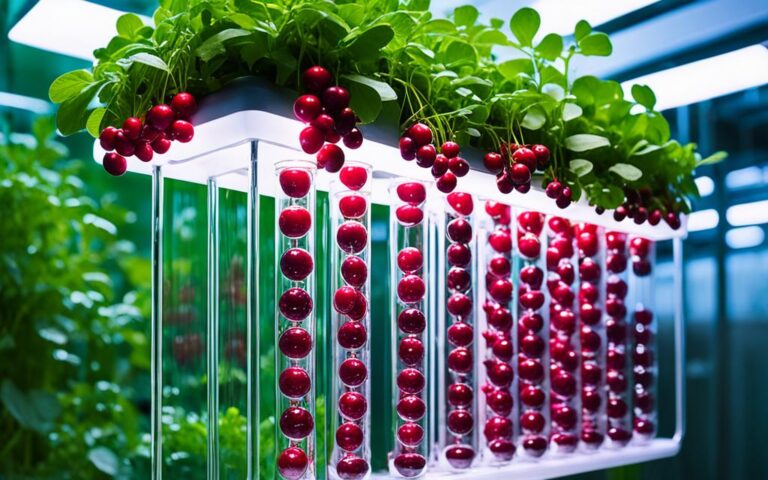Hydroponic Radicchio: Grow Tips & Nutrient Guide
Did you know hydroponic radicchio production has jumped by 300% in the last ten years? This method has changed how we grow this unique Italian chicory. Now, it’s easy for indoor farmers and home gardeners to grow it. We’ll share tips on growing top-quality hydroponic radicchio. You’ll learn about picking the best varieties and what nutrients they need to thrive.
Key Takeaways
- Hydroponic radicchio production has experienced a 300% increase in the past decade, making it a popular choice for indoor farming and home gardens.
- Careful selection of radicchio varieties, such as Chioggia and Treviso, is crucial for successful hydroponic cultivation.
- The right hydroponic system, nutrient management, and environmental conditions are essential for growing flavorful and nutrient-dense radicchio.
- Troubleshooting common problems, such as pests, diseases, and nutrient deficiencies, is key to maintaining a thriving hydroponic radicchio crop.
- Proper harvesting, post-harvest care, and culinary preparation can maximize the enjoyment and health benefits of this unique leafy green.
Table of Contents
Introduction to Hydroponic Radicchio
Hydroponic radicchio is a special type of Italian chicory grown in water, not soil. It’s part of a soilless system that has many benefits for growing this tasty vegetable.
One big plus of hydroponic radicchio is the control it offers. Growers can manage the nutrients, pH, and other factors to get perfect, tasty radicchio all year. This control is hard to get with traditional soil farming.
Hydroponic radicchio also means more produce. Without soil limits, roots grow better, making bigger, healthier plants. Plus, hydroponics keeps pests and diseases away, helping plants grow more.
Choosing to grow radicchio hydroponically depends on what you want. If you want a steady, high-quality supply of this beautiful vegetable, hydroponics is a great option. Knowing the benefits helps growers make the best choice for their radicchio.

Varieties of Hydroponic Radicchio
When growing radicchio hydroponically, several varieties stand out. Chioggia radicchio and Treviso radicchio are two top choices.
Chioggia Radicchio
Chioggia radicchio is a top pick for hydroponic gardens. It has a round head and deep maroon leaves with crisp white ribs. This type is known for its bold taste and is loved by chefs and home cooks.
Treviso Radicchio
Treviso radicchio is another great option for hydroponics. It looks like a romaine and tastes milder and sweeter than Chioggia. Its unique look and taste make it versatile for many dishes.
Chioggia and Treviso are the top types of radicchio for hydroponics. But, there are other tasty varieties like Castelfranco and Veneto di Rosa to try. The best radicchio for hydroponics depends on your growing conditions and taste.
| Variety | Appearance | Flavor | Suitability for Hydroponics |
|---|---|---|---|
| Chioggia Radicchio | Round, compact head with deep maroon leaves and white ribs | Bold, slightly bitter | Highly suitable |
| Treviso Radicchio | Elongated, romaine-like shape | Milder, sweeter flavor | Highly suitable |
| Castelfranco Radicchio | Pale green leaves with red splashes | Mild, nutty flavor | Suitable |
| Veneto di Rosa Radicchio | Rose-shaped head with deep red leaves | Slightly bitter, earthy | Suitable |
Exploring the many radicchio varieties grown hydroponically helps growers find the best fit for their needs and tastes.
Selecting the Best Hydroponic System
Choosing the right hydroponic system for radicchio is key. Growers have many options, each with its own benefits and things to consider. Knowing the details of these systems can help pick the best one for your radicchio.
The DWC system is a popular choice. It lets the plant roots hang in a nutrient-rich solution. The NFT system is another good option. It uses a thin film of nutrients to feed the plants.
Systems using a growing medium like coco coir or perlite are also great for radicchio. These systems give you control over the roots and can handle more plants.
| Hydroponic System | Pros | Cons |
|---|---|---|
| Deep Water Culture (DWC) |
|
|
| Nutrient Film Technique (NFT) |
|
|
| Media-based Systems |
|
|
When picking the best hydroponic system for growing radicchio, think about complexity, water and nutrient use, and how much you can grow. This will help you find the right setup for your goals and resources.
Starting Radicchio from Seeds vs Transplants
Growing radicchio hydroponically offers two choices: starting with seeds or using transplants. Each method has its benefits. The choice depends on what the grower prefers and the growing conditions.
Sowing Radicchio Seeds
Starting with radicchio seeds in hydroponics takes some extra care. But, it can be very rewarding. You need to sow the seeds in a controlled place, like a greenhouse, at a soil temperature of about 75°F for them to germinate well.
After the seedlings grow, you can move them to the hydroponic system. Make sure to space them about 8 inches apart.
Transplanting Radicchio Seedlings
Growers can also buy radicchio transplants and put them straight into the hydroponic setup. This gives them a head start since the seedlings already have strong roots. It can lead to a more uniform crop because the plants are more developed.
However, make sure the transplants are healthy and fit well in the hydroponic environment before adding them.
Whether you start with seeds or transplants, getting the radicchio plants to establish well is crucial. They need to grow into healthy, tasty heads. Think about your goals, resources, and what you prefer when choosing between direct seeding and transplanting for your hydroponic radicchio.
“Proper seed starting and transplanting techniques are essential for a thriving hydroponic radicchio crop.”
Nutrient Requirements for Hydroponic Radicchio
For hydroponic radicchio to grow well, it needs the right nutrients. It needs a balanced nutrient solution with important nutrients like nitrogen, phosphorus, and potassium. It also needs smaller amounts of calcium, magnesium, and trace elements. The ideal EC level is 0.8 to 1.2 mS/cm, which means 560-840 ppm on the 700 scale.
The best pH for hydroponic radicchio is between 5.5 and 6.5. Keeping a close eye on and adjusting the nutrient solution is key. This ensures the radicchio gets what it needs for strong growth and development.
| Essential Nutrients | Ideal Range |
|---|---|
| Nitrogen (N) | 50-100 ppm |
| Phosphorus (P) | 25-50 ppm |
| Potassium (K) | 75-150 ppm |
| Calcium (Ca) | 50-100 ppm |
| Magnesium (Mg) | 25-50 ppm |
By keeping the right nutrient levels and pH, growers can make sure their hydroponic radicchio gets what it needs. This leads to healthy growth and development.
Optimal pH and EC Levels
Keeping the right pH and electrical conductivity (EC) levels is key for growing radicchio hydroponically. The ideal pH range for radicchio is between 5.5 and 6.5. This range lets the plants take in nutrients well from the solution.
The optimal EC range is between 0.8 and 1.2 mS/cm, which is 560-840 ppm on the 700 scale. It’s important for growers to check and adjust the pH and EC often. If not, the plants might not get enough nutrients, grow poorly, and produce low-quality radicchio.
Understanding and controlling these key parameters is a fundamental aspect of hydroponic radicchio production.
| Parameter | Ideal Range |
|---|---|
| pH | 5.5 – 6.5 |
| EC | 0.8 – 1.2 mS/cm (560 – 840 ppm) |
“Maintaining the proper pH and EC levels is crucial for successful hydroponic radicchio cultivation.”
Temperature and Light Requirements
To grow radicchio hydroponically, it’s important to keep the temperature and lighting right. Radicchio loves cool weather and grows best between 60-65°F. If it gets too hot, above 77°F, the plants may stop growing.
For lighting, radicchio needs a mix of natural and artificial light, like LED or fluorescent grow lights. Giving them 12-14 hours of light daily helps with leaf growth and keeps the radicchio colorful.
It’s key to watch and control the environment for radicchio. This means keeping the ideal temperature for hydroponic radicchio and the lighting needs for growing radicchio hydroponically in check. Doing this ensures you get a good harvest of tasty radicchio.
| Environmental Factor | Ideal Range for Hydroponic Radicchio |
|---|---|
| Temperature | 60-65°F |
| Lighting | 12-14 hours per day |
“Maintaining the precise temperature and lighting requirements is key to growing exceptional hydroponic radicchio.”
Hydroponic Radicchio
Growing radicchio with hydroponics has many benefits for gardeners and producers. It lets you grow this tasty Italian chicory all year. You also have more control over growth factors.
For successful hydroponic radicchio, knowing the plant’s needs is key. Choose the right varieties, like Chioggia or Treviso radicchio. Then, pick the best hydroponic system for them. It’s also important to provide the right nutrients, pH, temperature, and lighting conditions.
Mastering growing radicchio in hydroponics, hydroponic radicchio cultivation, and producing radicchio in a hydroponic system lets growers get the most out of this crop. You’ll get everything from bright red heads to crisp, bitter-sweet leaves.
“Hydroponic radicchio cultivation allows us to produce this flavorful chicory year-round, with complete control over the growing environment.”
Whether you garden at home or produce on a large scale, exploring hydroponic radicchio is exciting. By managing key factors like plant health and productivity, you can enjoy a big harvest of this unique and tasty vegetable.
Common Problems and Solutions
Hydroponic radicchio offers many benefits, but growers may face problems. These can include pests, diseases, and nutrient issues. It’s important to address these quickly and effectively.
Pest and Disease Management
Hydroponic radicchio can be attacked by pests like aphids, fungus gnats, and whiteflies. Diseases such as root rot and powdery mildew can also happen. To fight these, use an Integrated Pest Management (IPM) plan. This combines cultural, biological, and chemical methods.
Keep the growing area clean, check on the plants often, and act fast if you see pests or diseases. This helps prevent and manage these issues.
Nutrient Deficiencies
Not getting the right nutrients can hurt hydroponic radicchio plants. This might show as slow growth, leaves that look off-color, or other signs. It’s key to watch the nutrient levels, pH, and EC closely.
Fixing troubleshooting hydroponic radicchio issues is vital for a healthy crop. By managing pests, diseases, and nutrients well, growers can ensure their radicchio grows well.
Harvesting Hydroponic Radicchio
Knowing when to harvest your hydroponic radicchio is key for top quality and yield. The best time to pick radicchio hydroponically is about 90 days after planting the seeds or moving the seedlings. Look for full, firm heads to know it’s ready.
To pick your hydroponic radicchio, use a sharp knife or scissors at the base. This ensures a clean cut that doesn’t harm the leaves. It’s best to pick in the morning, when the plants are fullest, to keep them fresh.
Handling the radicchio heads carefully is important. Avoid bruising or tearing the leaves to keep their color, texture, and taste great.
Using the right harvesting techniques keeps your hydroponic radicchio quality high. By picking at the right time and being gentle, you get a lot of this tasty and healthy vegetable.
“Harvesting hydroponic radicchio at the right time and with the right techniques is the key to unlocking its full flavor potential.”
Tips for Harvesting Hydroponic Radicchio
- Harvest when the radicchio heads are full and firm, typically around 90 days after sowing or transplanting
- Use a sharp knife or scissors to cut the plants at the base, ensuring a clean, minimally-damaging cut
- Harvest in the morning when the plants are most turgid to preserve freshness
- Handle the harvested heads gently to avoid bruising or tearing the delicate leaves
Post-Harvest Care and Storage
After you pick your hydroponic radicchio, it’s key to cool it down fast. This stops it from getting any riper. You can cool it using hydro-cooling or by putting it in the fridge.
For the best storage, keep the radicchio in your fridge’s coolest spot. Put it in a sealed bag or container to keep the moisture in. Under these conditions, hydroponic radicchio can last 7-10 days. But, watch out for wilting or bitterness, as it will get more bitter over time.
Following the best practices after harvesting is vital. By storing hydroponic radicchio and handling hydroponic radicchio after harvest right, you can make it last longer. This way, you get to enjoy the best post-harvest care for hydroponic radicchio.
| Key Considerations for Storing Hydroponic Radicchio | Recommended Practices |
|---|---|
| Cooling | Hydro-cooling or refrigeration to stop maturation |
| Storage Conditions | Coldest part of the refrigerator, in sealed bag or container |
| Storage Duration | 7-10 days under optimal conditions |
| Monitoring | Watch for signs of wilting or bitterness |
“Adhering to best post-harvest practices helps ensure the radicchio maintains its signature flavor and texture.”
Cooking and Eating Radicchio
Hydroponic radicchio is great for both raw and cooked dishes. It has a slightly bitter, peppery taste. This makes it a great addition to many meals.
Raw Radicchio Recipes
Radicchio is perfect in salads, slaws, and more when it’s raw. Here are some tasty recipes:
- Simple radicchio salad with citrus vinaigrette
- Radicchio and apple salad with candied walnuts
- Radicchio and goat cheese appetizer
Cooked Radicchio Dishes
Cooking radicchio brings out its flavor even more. Try these dishes:
- Roasted radicchio wedges
- Sautéed radicchio with olive oil and balsamic vinegar
- Radicchio braised with pork or chicken
The hydroponic radicchio has a unique taste. It goes well with sweet, salty, and acidic foods. Enjoy it raw or cooked, and it will make your meals special.
Learning how to cook hydroponic radicchio opens up a world of tasty dishes.
Health Benefits of Radicchio
Radicchio is more than just a pretty face and tasty flavor. It’s packed with nutrients that make it great for your health. Its deep red color comes from antioxidants called anthocyanins. These are linked to lower cancer and heart disease risks.
This veggie is also full of fiber, vitamins K, C, and E, and minerals like calcium. It’s a low-sugar option, perfect for those watching their blood sugar. Plus, its bitter taste can help with digestion by boosting digestive enzymes and stomach acid.
| Nutrient | Amount per 100g | % Daily Value |
|---|---|---|
| Calories | 13 | 1% |
| Total Fat | 0.2g | 0% |
| Carbohydrates | 2.9g | 1% |
| Fiber | 1.2g | 5% |
| Vitamin K | 170mcg | 212% |
| Vitamin C | 9mg | 15% |
| Calcium | 54mg | 5% |
Hydroponic radicchio is a top pick for adding nutrients to your diet. It’s great raw in salads or cooked in many dishes. Radicchio is versatile and boosts any meal with its health benefits.
“Radicchio is a nutritional powerhouse that offers a wealth of health benefits beyond its unique flavor profile.”
Tips for Maximum Yield
To get the best yields with growing hydroponic radicchio, follow some key steps. Keeping the right temperature, light, and nutrients is key. This helps in maximizing hydroponic radicchio yield and increasing productivity of hydroponic radicchio.
It’s important to check and adjust the pH and EC of the nutrient solution often. This ensures healthy growth. Also, keep plants about 8 inches apart to avoid crowding and ensure good air flow. Starting new radicchio batches every few weeks helps keep the harvest going.
Also, keep plants stress-free by quickly dealing with pests, diseases, or nutrient problems. This helps in growing tips for high-yielding hydroponic radicchio. By doing these things, growers can get the most out of their hydroponic radicchio.
| Tip | Description |
|---|---|
| Maintain Optimal Conditions | Ensure proper temperature, light, and nutrient levels for robust plant growth. |
| Monitor and Adjust pH and EC | Regularly test and adjust the nutrient solution to maintain optimal levels. |
| Provide Adequate Spacing | Allow approximately 8 inches between plants to prevent overcrowding. |
| Implement Succession Planting | Start new batches of radicchio every few weeks for a continuous harvest. |
| Address Stress Factors | Quickly identify and resolve any pest, disease, or nutrient issues. |
“By following these best practices, growers can maximize the yield and quality of their hydroponic radicchio crop.”
Conclusion
Hydroponic growing is a great way to get tasty, healthy radicchio all year. By picking the best varieties and setting up the right hydroponic system, growers can get top-notch radicchio. It’s all about managing the nutrient solution and pH, and giving it the right temperature and lighting.
Also, it’s key to know how to handle pests, diseases, and nutrient deficiencies. This helps boost yield and keep the radicchio tasting great. Whether you’re a pro at hydroponic farming or just starting, this article has tips to help you grow radicchio hydroponically.
This summary shows how growing radicchio hydroponically is valuable and doable. It’s a new way to grow this tasty and healthy veggie.
